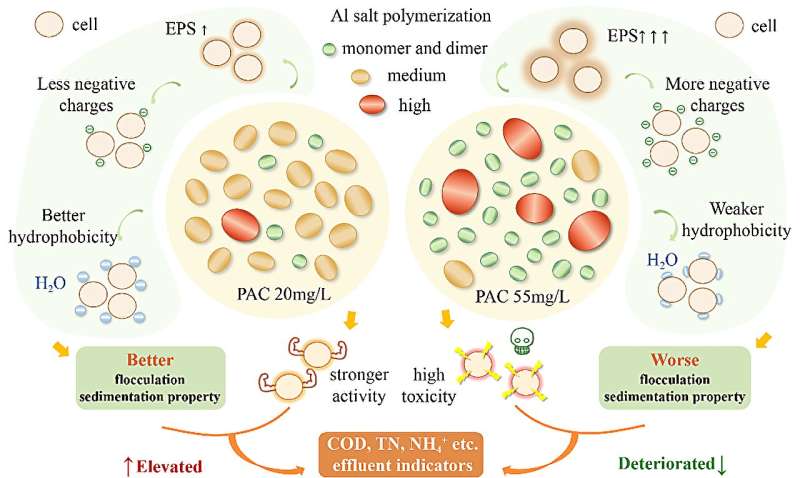This article has been reviewed according to Science X's editorial process and policies. Editors have highlighted the following attributes while ensuring the content's credibility:
fact-checked
proofread
Influence of residual aluminum hydrolyzed species on activated sludge properties in industrial wastewater pre-treatment

Given that previous studies have neglected the potential mechanism of the difference in aluminum content affecting the activated sludge system, a research team from Wuhan University of Technology has investigated the morphology distributions of residual aluminum salts (RAS) and their effects on the removal efficiency of activated sludge (AS) under different PAC concentrations, and revealed the internal mechanisms of the effects of the excessive and appropriate concentrations of RAS on the AS system.
The paper is published in the journal Frontiers of Environmental Science & Engineering.
This work improved the dominance of medium polymeric RAS, formed under an appropriate PAC dose of 20 mg/L enhanced the hydrophobicity, flocculation, and sedimentation performances of AS, as well as the enzymatic activity in cells in the sludge system, improving the main pollutants removal efficiency of the treatment system.
The activated sludge (AS) method has been extensively utilized in industrial wastewater treatment systems worldwide due to its strong economy, excellent treatment efficiency, and strong adaptability to practical application. However, for the increasing content of organic suspended matters in industrial wastewater, physical and chemical methods must be introduced as auxiliary processing for biological treatment.
Among them is the coagulation-sedimentation process, a pretreatment technology with the advantages of simple manipulation and cost-effectiveness. However, it is worth noting that a small number of metal salts still remain in the subsequent biological treatment units.
Early studies confirmed that the long-term accumulation of the residual metal entering AS system would negatively affect the properties and bioactivity of the sludge, the community structure of microorganisms, and in turn, the system treatment efficiency. Nevertheless, as the research continued to deepen, it was found that low levels of toxic metals could coordinate with freely dissolved EPS secreted by cells.
It is illustrated that the accumulation of metals within an appropriate concentration range might be beneficial to certain aspects of AS. However, few studies have comprehensively explored the internal mechanism behind the difference in Al contents and assessed the correlation between various physical-chemical and biological parameters influencing the AS properties.
To fill these gaps, researchers from Wuhan University of Technology comprehensively explored the internal mechanism behind the difference in Al contents and assessed the correlation between various physical-chemical and biological parameters influencing the AS properties.
In this study, the research team explored and analyzed the following questions: 1) Determine the coagulant dosage beneficial to the reaction through various indicators of the reactor effluent and AS. 2) Evaluate the influences of RAS on the AS system using several indicators, including EPS, relative hydrophobicity, surface charge, electrolyte seepage volume, etc. 3) Explore the internal mechanisms of the effects of the excessive and appropriate concentrations of residual aluminum salts (RAS) on the AS system through analyzing the influence rule of the distribution of Al hydrolysis species.
Based on the analysis of the species distribution of aluminum brine hydrolysis, their study focused on the effect of different RAS concentrations on the AS system in the subsequent biochemical treatment unit after coagulation pretreatment. Their results showed that the moderate polymeric RAS formed at an appropriate PAC dose of 20 mg/L was dominant, stimulating the secretion of EPS and decreasing the surface charge of the sludge.
In addition, the heightened AS hydrophobicity and the sludge surface charge neutralization by Al salts resulted in better flocculation and settling performance, which improving the main pollutants removal efficiency of the treatment system. Comparatively, the species composition with monomer and dimer / high polymer RAS as the overwhelming parts under an overdosed PAC concentration of 55 mg/L resulted in excessive secretion of EPS with loose flocs structure and conspicuous inhibition of cellular activity, leading to the deterioration of physico-chemical and biological properties of AS.
This study not only reveals the influence of RAS hydrolyzed species distributions on the comprehensive properties of AS, which is closely relevant to the dosage of Al, but also provides a theoretical reference for the precise control of coagulant dosage in industrial wastewater pretreatment.
More information: Ziqi Zhao et al, Evaluation of activated sludge properties' changes in industrial-wastewater pre-treatment: role of residual aluminum hydrolyzed species with different polymerization degree, Frontiers of Environmental Science & Engineering (2023). DOI: 10.1007/s11783-023-1675-3
Provided by Higher Education Press





















